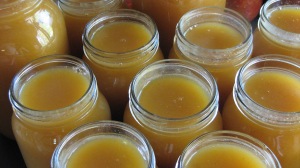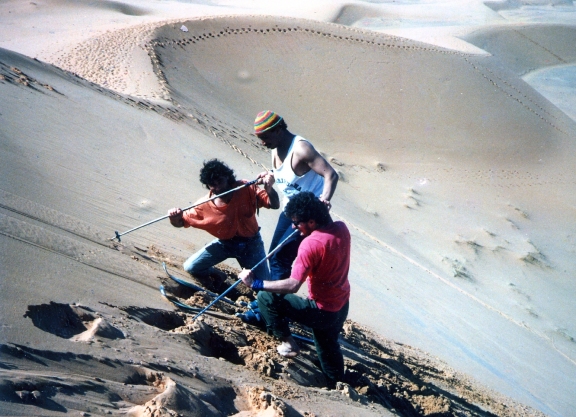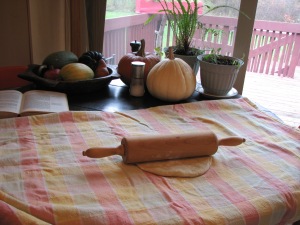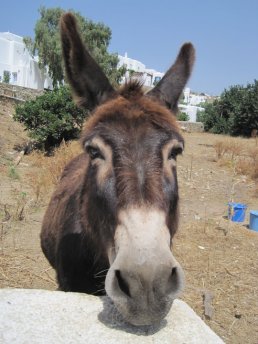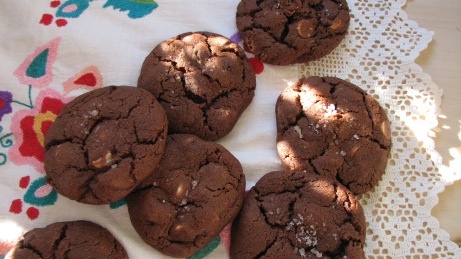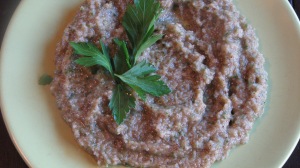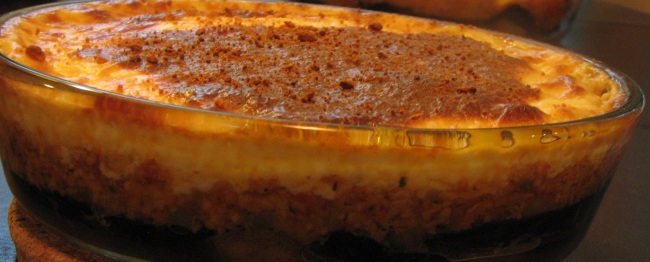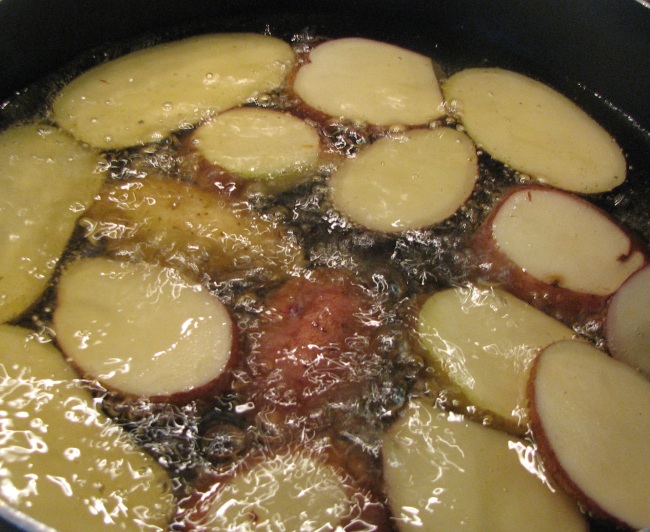I won’t do a post about fall colors and the sounds of rustling leaves as they are joyously walked through. I’ve read too many recently and I’m thinking about October in another way today.
Greece – October 1988
We were all extremely exhausted after a grueling seven month tourist season of 13 hour/seven day work weeks. We needed a change of scenery, some good food we didn’t necessarily have to cook ourselves, and a place to sleep uninterrupted until our systems got caught up again.
On the suggestion of one of our crew, we headed to northern Greece. Macedonia. Achilles’ and Alexander’s stomping grounds. Lands of fabled creatures; half man, half horse. Home of the twelve Gods. I had just finished reading Mary Renault’s Alexander trilogy so my mind was full of history and mythology. We would find a lazy route up Mount Olympus, numerous beautiful and inexpensive lodgings, a full service lodge for hikers with delicious food, and unparalleled scenery. Made to order.
We traveled by bus from Thessaloniki to Katerini, then on to the town of Litoxoro. From there, two helpful taxi drivers crammed us and all our stuff into their vehicles and drove us up higher into the forest to a trail that would lead us to the monastery of Agios Dionisiou built on a rock ledge over the Enipeas river and gorge. From there we would follow an official trail (E4) up towards the hikers lodge where we could sleep some more before we made the final assent to the top of Olympus.
We reached the monastery at dusk after a longer-than-expected haul through deep, thick, virgin forest. We were carrying too much unnecessary junk (bread, cookies, a birthday cake, balloons, wine, tomato sauce, etc), had no proper shoes, and had no clue as to what we were getting ourselves into. Hungry, and even more exhausted than when we left Athens a few days earlier, we looked at the monastery in front of us with a mix of curiosity and dismay at the work we definitly needed to do in order to provide some basic comforts. What we found in front of us was a dilapidated old monastery with nothing cozy about it. Half the stone building around the courtyard had tumbled down after years of neglect, leaving a huge wall with arched openings where windows may once have been. We walked past them to the center of the courtyard where a small chapel remained with a sagging round roof; ceramic tiles missing in some places, patched in others. A pot of fresh basil stood next to the low entrance of chiseled marble. Inside, a candle could be seen burning next to the icon of a saint. Amongst the fallen stones in the courtyard a path had been swept and cleared. We followed it to a more intact part of the old monastery which seemed to contain some creepy looking rooms.
Water from a re-routed spring dripped onto a marble trough built into the side of the rock wall. The monastery was built on the ledge of a steep cliff.

From top left, clockwise: 1) me looking down to the gorge below the monastery, 2) the monastery, 3) hiking along the Enipeas River, 4) lighting a fire to add some heat to our celebrations, 4) the dilapidated center of the courtyard. (Click the picture to zoom in)
Suddenly we heard something stir and we looked up to the second floor and a balcony along which was a series of rooms, or cells. Two cells had no doors and out of one them appeared a tall grey figure. We instantly tensed and huddled. The figure came towards us out of the shadows he was standing in. It was a monk with a long scraggly beard and even longer hair tied back. He wore the black robes typical of orthodox priests; this one patched in places, actually more gray than black.
“Καλός ήλθατε (Welcome),” he said with the softest voice ever.
He moved to the other side of the balcony towards the stairs, opening the doors to two rooms as he passed. Then he returned to the room he had originally appeared from and brought out a large basket and a plastic bag.
“Ελάτε εδώ πάνω (Come up here),” he said moving into one of the rooms.
Nikos immediately sprang forward towards the stairs, followed by Petros. Ritsa explained to me that monks often lived in old monasteries like this, preferring a secluded life. They also played the role of guardians to valuable icons or relics of saints. She told me that they must also abide by the rules of hospitality to strangers and travelers by sharing whatever comforts they have.
Upstairs we found our two companions sitting on low stools lighting oil lamps while our new friend, Papa Yiorgi, went about lighting a fire. He made tea, then pulled out cheeses, smoked meats, dried figs, and walnuts out of his basket. He cut up some tomatoes in a deep plate, added a handful of olives, then liberally poured olive oil over it all. He pulled some dried oregano out of the plastic bag and rubbed it between his large hands, sprinkling everything in the bowl with the dried herb. He had hands like a builder who worked with marble and stone and it made an impression on me because I had been expecting old, frail, hands. He explained to us how he kept a goat, made his own cheese, and was relatively self sufficient even though the villagers often came by bringing him bread and treats. The villagers also came to visit the chapel, he explained. Inside it was a very old box containing some of the saint’s bones. The villagers often came by to pray, and ask for the saint’s blessings and of course, leave provisions for the old priest who guarded him.
We pulled out our bread and cookies, and between us all we shared a great meal. When we had eaten, the priest went into his room one more time to bring us a bottle of tsipouro that he had received from some visitors earlier. He declined to join us, telling us that he wanted to rest. He wished us a good night, and left.
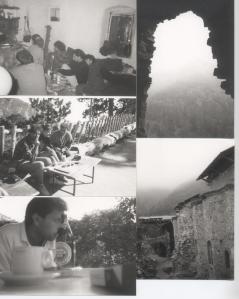
Clockwise from top left: 1) waiting for the water to boil. 2) the view from the outhouse built directly over the gorge, 3) more dilapidated walls, 4) Petros with a well earned beer, 5) Hanging out at the Hiker’s Lodge.
(Click on picture to zoom in)
The room was warm, dry, and swept clean. Other than the low stools and a low table made out of what looked like a slice from an ancient column, the floor was covered by many thick hand woven rugs and blankets. More were folded in a corner in a tall stack. We found the same was in the other room where we lighted a second fire. Plastic covered the windows to keep out any drafts. We rolled out our sleeping bags and slept feeling happy, sated, and safe.
The next morning was misty and cool as a fog rolled off Olympus and down through the gorge. We could hear the river passing under the cliff that the monastery was built on, but we couldn’t see it, so we decided to rest and wait for better weather before climbing the mountain higher. We stayed at the monastery for two more days; eating, taking short walks through the woods, having a birthday party, sleeping, and drinking tsipouro. The old priest joined us often and told us stories about his visitors and some of the pilgrimages they had made in honor of the saint whose bones he guards.
When the weather cleared we laced our flimsy sneakers and pulled on our packs in preparation to tackle a small portion of the mountain, before reaching the Hiker’s Lodge. We followed gorgeous scenery along the Enipeas River, part of the E4 European hiking trail, until signs directed us to head up along an ever more narrowing and steeper path. I had to make myself go into a trance to forget the weight on my shoulders and the pain in my feet and legs. I had long conversations in my mind, berating myself for being such an idiot for thinking that Olympus could be climbed by a “lazy route”. We climbed for many, many hours.

Sometimes the path was a series of steps chiseled out of the mountainside, other times, we were simply scrambling over stones; up, up, up, the signs kept saying.
My legs were like jelly when we reached the hiker’s lodge. I was too tired to appreciate the scenery. I didn’t see the huge outdoor patio amongst the fir trees. I honestly didn’t give a shit at that point. I was blind with exhaustion and my feet were blistered and in pain. We were served dinner by a huge fireplace. Huge portions of bean soup, thick slices of toasted bread rubbed with garlic and drizzled with olive oil, and wine. Lots of wine. Sitting on the wooden benches and leaning against the rug covered walls, I felt virtuous because I was climbing that mountain. Then I passed out.
Above the dining area of the lodge, the attic space had been divided into two areas of open floor space, each capable of boarding at least 25 people. One area for the men, one for the women. In a corner of each space, were piles of foam mats that could be borrowed and lain on the wooden floor under ones’ sleeping bag. Somehow I managed to get up there because that’s where I woke up.
We had only one last leg to reach the top of the mountain.
Going up, and coming back down would be done in the same day since it was only a few hours each way. No trees, no lodges, no bean soup, no wine up there. I wasn’t the only one exhausted. Our friends from Thessaloniki decided that they would forsake this final privilege of hauling themselves up the mountain, promising they would attempt it again some other time. Petros and Nikos of course were going up, and me… well, let’s just say I felt challenged in spite of it all.
We set off after a fortifying breakfast. We left our packs behind with our friends, taking only a small day pack with water and dried figs – a gift from the priest.
We climbed and climbed and climbed, and soon we cleared the tree line. In front of us was a trail walked by thousands, a mere shade lighter than the terrain surrounding it, cleared of stones, and marked by the feet that had pressed it into being.
I was tiring faster than the boys who kept moving way ahead of me. At some point I lost them, but saw a vertical wall of stone to my right, which looked more fun than that slow and steady incline that was killing my legs. It didn’t look all that high and it was definitly a short cut. I decided to climb it. Looking back now, I am amazed at my audacity to climb that thing without ropes, without a helmet, or even a partner. I just climbed it and when I had reached about half way up, I looked down and realized that if I fell down, I would die. I hadn’t calculated how different the height would appear from the foot of the rock wall, and how big it would be when I was actually up on it. I saw Petros and Nikos, as they saw me from the snaking path that they were on.
“Keep going! Don’t look down! We’ll meet you at the top!”, they yelled into the warm southern wind which carried their voices to me.
I kept climbing, one move at a time. My arms and legs were straining but I didn’t have any more choice in the matter. I had to keep going and tried very hard not to look down. I reached the top and hauled myself over the edge and lay there until the boys caught up to me. I was completely done in and couldn’t get up. Maybe the air was thinner up there, maybe I had used the last of my resources, but I wasn’t going one more step.
The boys urged me to get up and join them for the last easy walk to the top. It did look easy. The path went up a short ways then along the top of a ridge, to another peak in easy distance. Maybe no more than a half hour’s walk. But I couldn’t. It took a lot of convincing to make them go and at last they did. With a few tears in my eyes I lay there and watched them as they reached top, then return to where I was lying. It was very beautiful up there. They helped me to my feet, and together we slowly hobbled down the path that led us back to the lodge. We stayed there another two days before we climbed back down the mountain.
One week later I flew home to my mom in Austria and slept for a week.

In the fall I like to cook a lot of things that have pumpkin as an ingredient. I couldn’t find canned pumpkin in Greece because they don’t really cook with it as much as here in the states, so I taught myself how to process pumpkin. I hope to post many recipes that focus on this beautiful gourd, but before I can show you any of these, I need to first show all my friends in lands without canned pumpkin, how to have this ingredient at hand all throughout the year.
Processing Pumpkin for Later Use

First you need to accumulate a few pumpkins designated for cooking. These you can usually get a bit cheaper than the pumpkins used for decorations. We just recently got a huge more box for $5 from a stand at the side of the road, because they were weird shapes, or maybe a tiny bit bruised, which is OK for processing/cooking. The riper, the better, the sweeter.
The Oven method is the easiest way to cook the pumpkin without them accumulating extra moisture – like from boiling or steaming.

An oven full of pumpkin halves.
Roast at 350F (170C) for about one hour, or when the pumpkin is soft. When done, empty the water that has accumulated in its center.

Let everything cool and take some pictures because it looks impressive. 🙂

On the table is my ceramic yard fairy. A gift from Ceramist Alma Moriah – Winik.
Scrape the cooked pumpkin into a sieve that has been placed into the sink. Allow it to strain (stirring it up every half hour or so) for about 4 hours.

Line a cup container (a plastic yogurt container would do) with a sandwich bag, and fill with strained pumpkin goop. Twist and seal each bag. When done, place all small bags into a larger zip-loc bag to help prevent freezer burn. Place in freezer until ready to use. Cup sized portions are practical because they can easily follow smaller recipe amounts.


How To Make The Pumpkin/Apple Butter That Snuck Into The Above Photograph:
When I start processing Pumpkins, then I also prepare something with it while I have it fresh. These days I had a bunch of apples that grew on an abandoned tree and of course had to pick some. Pesticide and fertilizer free apples! They had a few wasp stings, but nothing that a knife tip couldn’t get rid of.
So I peeled the apples [about 12 pounds (6 kilos)], and threw them in a huge pot with a little fresh apple cider on medium heat so they wouldn’t burn. When bottom half of the apples in the pot had turned to mush, I stirred it all up, then added some pumpkin chunks [about 6 pounds (3 kilos)] that I had previously peeled. About half the amount of apples in volume. I’m sorry, but I was totally playing it by ear. All guesswork and estimation. I lowered the heat and left it on a low slow simmer until the pumpkin cooked and some of the liquid cooked out.

That enamel lard pot (schmalztopf) was my grandmother’s. It now serves as our Kitchen Compost Collector. 🙂
Then I added to the pot of thick bubbly mush:
1 tablespoon cinnamon
1 teaspoon clove
1 teaspoon allspice
I brought it to a full boil then added 6 cups of sugar to what appeared to be almost 2 gallons of mush. I kept stirring (you will need to protect yourself from burns at this point because the mush will be thick and sputtering out glops of very hot stuff until the sugar is dissolved) and brought it to a rolling boil again.
I added 4 packages of low sugar pectin and and kept stirring at a low boil until it was completely dissolved.

In the meantime, jars had been sterilized, which I filled with the Pumpkin/Apple Butter. They were canned in a hot water bath for 15 minutes.
